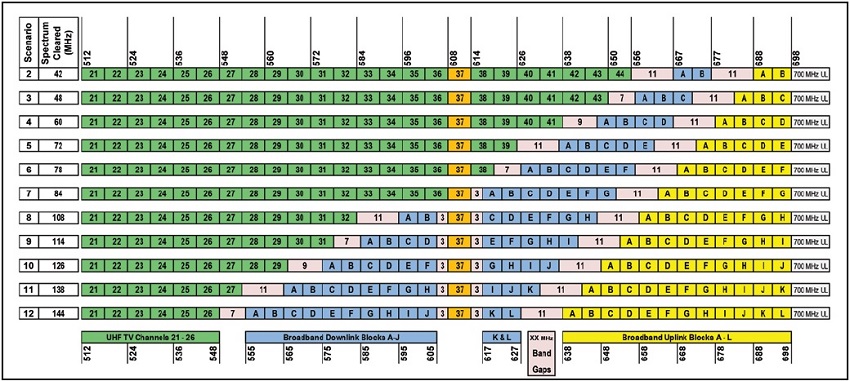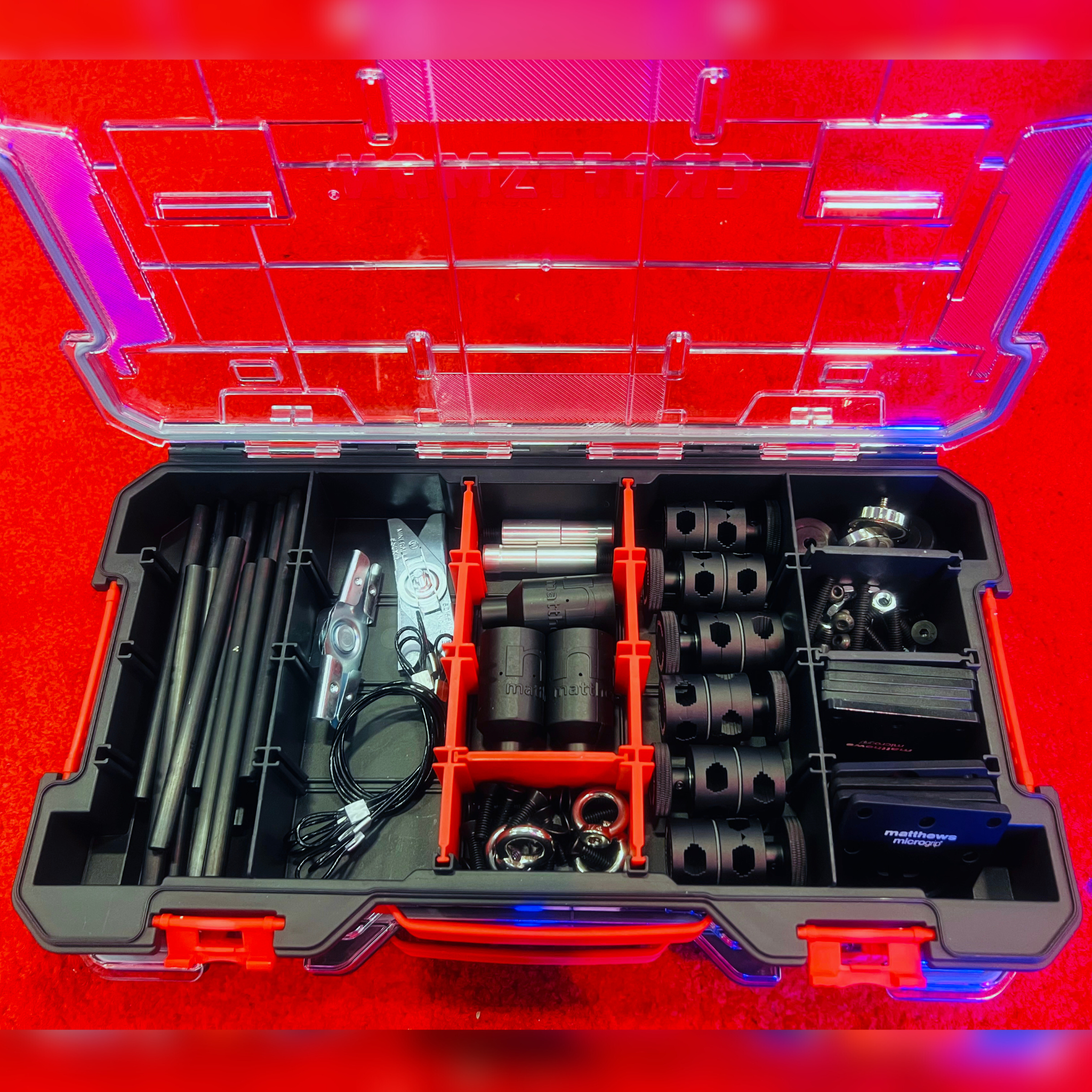Assessing Post-Repack Channel Options
It’s a given that there is going to be considerable “channel shuffling” after the upcoming television broadcast spectrum auctions. There also will be a lot less in the way of channel slots to choose from in the subsequent station repacking action. In 2014, the FCC adopted methodology for predicting interference between TV broadcasters and broadband wireless transmitters that are operating either in co-channel or adjacent-channel frequency slots. The commission termed their interference-prediction methodology, which is based on the Longley-Rice propagation model, “ISIX.”
Fig. 1: Derived from Fig. 23, page 453 of FCC document 14–50 dated May 15, 2014 by Stanley Knight
Click to Enlarge Looking at some cases where ISIX interference cases may come into play, suppose your station were to be allocated Channel 28 (center frequency = 557 MHz) in Scenario 7 (see Fig. 1). Your general manager might ask you to become a fortune teller and tell him whether this is a robust channel or a not so robust.

An ISIX interference situation may result if there two strong signals whose center frequencies are F1 and F2 and your center frequency is below F1 by the difference in frequencies F2–F1. IM3 falls in Channels N and N+3, if there are strong undesired signals on Channel N+K and N+2K. (K is an integer, either positive or negative).
For example, if there is a signal on Block A 619.5 MHz, (N+K) and a second signal is centered at 682 MHz, (N+2K) then F2–F1 = 62.5 MHz. Subtracting 62.5 MHz from F1 = 557 MHz, the center of your channel.
In this example F1 is in the blue area, meaning F1 is being radiated by a base station. F2 is in the yellow area, meaning this signal is being radiated by a cellphone.
INTERFERENCE CAUSES NOT ALWAYS APPARENT
Base stations radiate most of the time and their effective radiated power (ERP) approaches 1,000W. Cellphones briefly transmit and their ERP is less than 23 milliwatts. ISIX interference may result only when both F1 and F2 are transmitting simultaneously. Moreover, in this example F2 will be strong only if the cellphone is extremely close to the DTV receiving antenna. If either F1 or F2 is not strong, there can be no ISIX. However there are many base stations serving a given community, and many base stations will be found near interstate and other major highways.
Many viewers rely on an indoor antenna so your received signal power from these indoor antennas may be quite weak even when the receiver is not near your noise-limited coverage perimeter. Base stations are generally only a few miles apart. Therefore ISIX may be found around base stations.
While the first 600 MHz auction will auction 5 MHz blocks, after that most successful bidders will have acquired two or more blocks of 600 MHz spectrum. I expect that many of them will bid for contiguous blocks of 600 MHz spectrum so that they wind up with 10 MHz “super blocks,” which will be far more profitable than individual 5 MHz Blocks.
Fig. 1 shows that the spectrum for uplinks and down-links are equal for a given scenario. For Scenario 7, there are seven 5 MHz blocks for uplinks (cellphone Tx) and seven more for down-links (base station Tx).
This would allow up to three 10 MHz super blocks plus one 5 MHz block; or two super blocks and three 5 MHz blocks; or one super block and five 5 MHz blocks. For example, there could be three super blocks: A*B, C*D, E*F and one 5 MHz block, G. Or there could be super blocks B*C, D*E and F*G with one 5 MHz block A. There are many other combinations of 5 MHz blocks and super blocks 10 MHz wide.
The LTE signal bandwidth is 4.5 MHz for a 5 MHz block, and it will be 9 MHz for a super block of 10 MHz width. This means that the effective radiated power of a super block of 10 MHz is 3 dB greater than for a 5 MHz block. There is another subtle difference between the 5 MHz blocks to be auctioned initially, and 10 MHz super blocks. ISIX interference generated in a receiver is spread over 3*4.5 = 13.5 MHz. A 10 MHz super block will generate ISIX interference spread out over 27 MHz.
So the problem of ISIX interference to the reception of an ATSC signal will be far greater with super blocks (10 MHz wide) than with 5 MHz blocks for these reasons. However the FCC does not consider ISIX except for co-channel interference (CCI) or adjacent channel interference (ACI). Broadcasters should be concerned with the fact that ISIX interference can arise from signals offset in frequency by more than 6 MHz because the FCC will not consider offsets between DTV signals and LTE signals greater than 6 MHz. Two super blocks of 10 MHz each may generate third-order distortion products spanning 27 MHz! This is well known, but not recognized by the FCC as causing “harmful interference.” Where it happens the affected receive cannot look to the Commission or broadband operators for relief. This was pointed out in my June column “FCC ‘Harmful Interference’ Definition Gives Wireless a Pass” on www.tvtechnology.com.
ANOTHER INTERFERENCE EXAMPLE
Looking again at Fig. 1, you will note that the frequencies of LTE signals for a given block vary with the scenario number. Therefore you will need to know what blocks will be radiating LTE signals in your community. Whether the FCC will identify the scenario it applies for your market and your new channel number or just your channel number remains to be seen.
We will start with super block D*F whose center frequency is 639 MHz. F2 = 639 MHz. F1 is equally distant between Channel 28 and the center of super block E*F. So F1 = 0.5(639–557) = 598 MHz. This is in the green portion of the 600 MHz band, which for Scenario 7 is a TV channel (Channel 35). So here we have a hybrid of undesired signals, one LTE signal on super block E*F and DTV signal on Channel 35. Channel 35 will not cause CCI or ACI to Channel 28, so it is quite probable that there may be both Channels 28 and 35 in the repacking scheme for your community. But, there also may be ISIX to your Channel 28 signal from this combination of super block E*F and Channel 35 signals, however the FCC does not recognize such interference as being harmful interference.
With these facts, you will be able to answer questions about how your station will fare after repacking.
Charles Rhodes is a consultant in the field of television broadcast technologies and planning. He can be reached via email atcwr@bootit.com.
Get the TV Tech Newsletter
The professional video industry's #1 source for news, trends and product and tech information. Sign up below.
